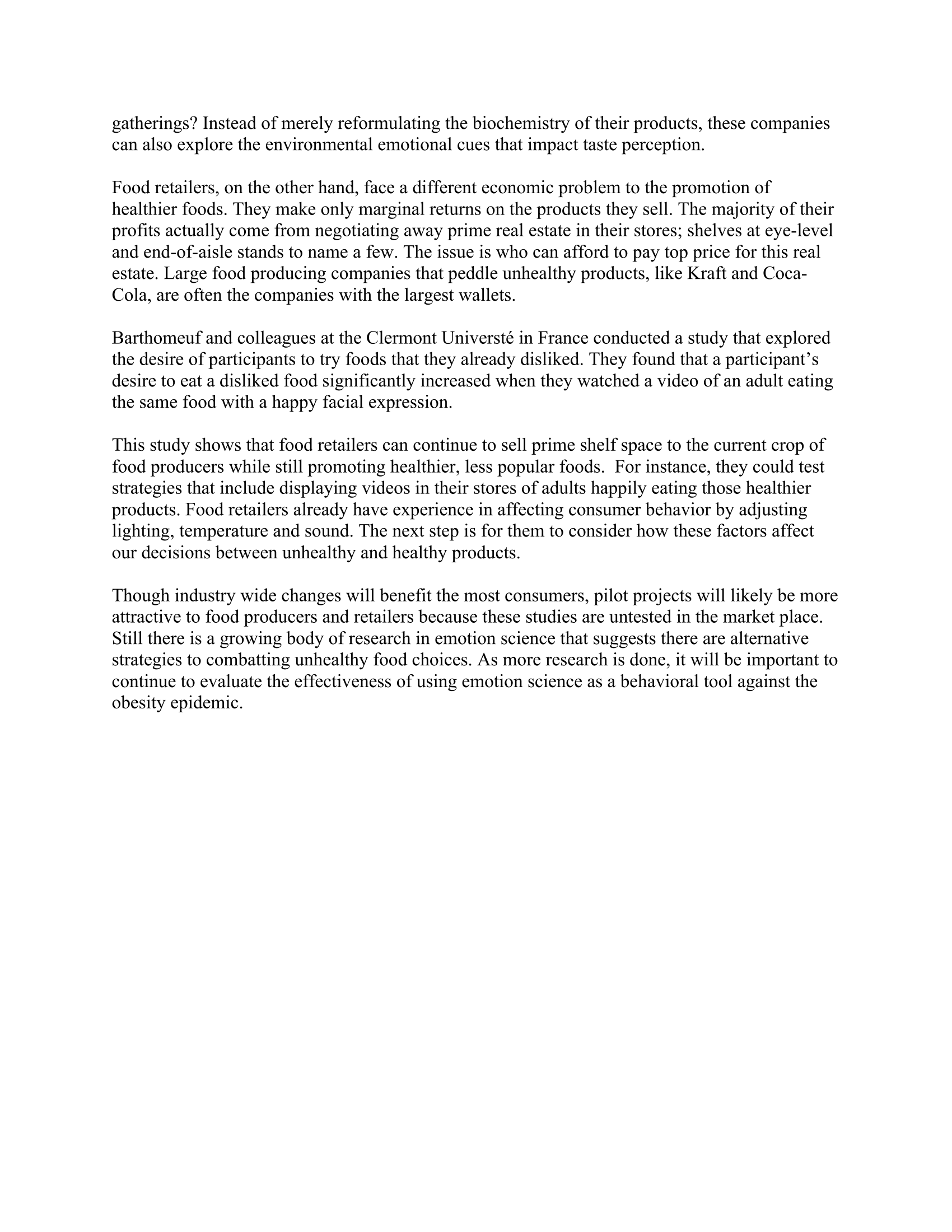OVERVIEW
ROLE: Academic Researcher; Graphic Designer; Data Visualizer; Storyteller
THE CHALLENGE: Elucidate a public problem and design a solution by bringing scientific findings on emotion to bear on it.
TIMEFRAME: 6 weeks
SOLUTION: Conduct rigorous academic research regarding the relationship between emotion and food-related decision making. Distill and utilize the findings to develop theories for reducing the barriers the food industry faces in promoting health. Develop and design a succinct and clear persuasive speech. Incorporate feedback from peers into a final op-ed piece to submit to news agencies.
SKILLS USED: Expert Review; Taxonomies; Value Proposition; Brainstorming; Storyboards; Blueprint; Sketching; Design Library; Paper Prototyping; Qualitative Feedback;
BEHAVIORAL INSIGHTS USED: Persuasive Presentation; Negotiations;
TOOLS USED: Illustrator; InDesign; PhotoShop; NounProject; Word; PsycARTICLES; PsycINO; GoogleScholar; COLOURlovers, Kuler
PROCESS
PLANNING & RESEARCH
Expert Review: Having spent most of my degree working on research in food-related behavior and obesity, I had a particular interest in the realistic barriers preventing the food industry from acting on behalf of public health. After speaking with the previous President of Stop n' Shop I was alerted to the primary problems that supermarkets and food manufacturers face in improving the health of their products or the presentation of their products. This inspired a direction in what type of behaviors I was looking for that could be altered by emotional states and that provided a thoughtful value proposition to these companies. I then brainstormed with a leader in Affective Science, Jennifer Lerner, for how to discover robust literature within this field.
Taxonomies: After an exhaustive search of PsycARTICLES, PsycINFO, and GoogleScholar for peer-reviewed and frequently-cited literature related to emotions and food-related decision making, I began developing taxonomies of the research themes. In doing so, I was able to illuminate the robustness of the themes and identify two in particular to apply to my thesis.
DESIGN
Color Design: After developing my argument I began working on the design of the presentation. I used a the site, COLOURlovers, for preliminary research of color palettes used for "science" + "presentation" and filtered by most liked and most downloaded. I then used Kuler to develop my own color palette based upon clarity of information and its relatedness to the content. I decided to use "red" as my accent because it represented the studies that utilized "romantic love" as an independent variable and could also be easily visually tied to food (i.e. strawberries).
Font Selection: Quicksand, a Sans Serif font, was the natural selection since "clarity" was one of my key goals in the presentation. Where I could I would reduce the number of words I was using and/or replace them with visualizations.
Graphic Design: I utilized the website, NounProject, to develop the majority of my images with a consistent style. This allowed me to devote more time on interpreting and designing the visualizations from the research I would be presenting.
TESTING
Persuasive Presentation: The behavioral science of negotiations was a helpful structure for exploring arguments that would resonate with my target audience: supermarkets and food manufacturers. It was important that I demonstrated empathy, clearly communicated my story, and inspired an easy-to-remember call to action. I then practiced everyday for 2 weeks and presented the speech as I would to key stakeholders. The following is the final version of the slide deck as it was presented:
Qualitative Feedback: My peers and mentor thoughtfully evaluated my presentation on the quality of my thesis, the evidence provided, and the conclusions I drew. They elaborated on the strengths as well as areas for improvement. The following are snippets from their feedback that I would use to incorporate into my op-ed.
“Your slides were exceptionally visually appealing, simple, and engaging. Similarly, your presentation style was very accessible with perfect pace and clarity. You plainly set out your structure and stuck to it throughout your talk. Stating your problem and thesis in such succinct terms made your topic relevant and interesting for a wide audience. Your evidence supported your thesis really well, with some quite fascinating findings - love makes things sweeter! - while you also underlined its limitations.”
“Ben could have done a better job laying out his problem clearly. I was a bit confused in the beginning what issue he was trying to address: obesity prevalence too high? people unable to control themselves while eating? irresponsible advertising on the retailers’ end? Manufacturers using too much salt/sugar/fat? I understood the scope of the problem in the conclusion, but the presentation could have benefited from him stating outright the problem that he was addressing.”
“Ben had very solid recommendations that were clearly rooted in affective science and strong studies. The studies he chose were clearly related to his problem, and they had strong implications for each part of his problem. He explained in a way that was easy to understand and used effective graphic. He suggested pilot studies, which are a realistic next step in securing evidence before affective science can directly shape policy. His discussion of the limitations was thorough and addressed the many variables that complicate studies of how emotion and food operate.”
“I think it would still have been insightful to have the consumer as one of the actors since whatever the others actors may do; the decision to purchase and eat certain foods still remains with the consumer. I would therefore have expected a brief discussion of scientific studies that had been done to directly target the consumer and behavior change in purchasing and consuming certain foods.”
SOLUTION
Issues: The feedback I received was generally very positive regarding the design of the presentation, my performance, and the application of the selected research. Although many people understood the problem I was trying to address, there were still many who were not able to identify my premise, suggesting to me that this was an area that I still needed to improve. Other peers raised bigger issues with the general actors that I chose to approach, highlighting important arenas to pursue in future discussions.
Results: With the remaining week I had left to integrate this feedback I focused my efforts on increasing the clarity of the problem I was addressing. After another seven revisions with additional feedback from trusted mentors and colleagues, I submitted the following piece as my final op-ed:





